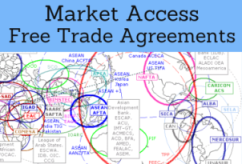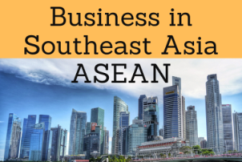Trade Agreements in Southeast Asia
Free Trade Agreements and Institutions related to countries analyzed in the Professional Diploma in Business in Southeast Asia ASEAN

Trade Agreements in the ASEAN Countries (Southeast Asia) (Brunei, Myanmar, the Philippines, Singapore, Thailand, Vietnam, Cambodia, Indonesia, Malaysia, and Laos).
In the ASEAN Region (Southeast Asian Nations) there are several Trade Agreements, both regional (ASEAN) and extra-regional (APEC, Trans-Pacific Agreement...).
Furthermore, each ASEAN country can have Trade Agreements with the third countries. For example, Singapore has Trade Agreements with Peru, Panama, Australia, China, South Korea, the EFTA, the U.S., Japan, Jordan, New Zealand, and India, and is a member of the Comprehensive and Progressive Agreement for Trans-Pacific Partnership.
A company wishing to do business in the region (Brunei, Myanmar, the Philippines, Singapore, Thailand, Vietnam, Cambodia, Indonesia, Malaysia, and Laos) should know all these trade agreements in force for all the target markets in the region.

The module includes the following Free Trade Agreements and economic institutions related to foreign trade in the region.

Masters adapted to the ASEAN Students:  Brunei,
Brunei,
 Cambodia,
Cambodia,
 Indonesia,
Indonesia,
 Laos,
Laos,
 Malaysia,
Malaysia,
 Myanmar,
Myanmar,
 Philippines,
Philippines,
 Singapore,
Singapore,
 Thailand, and
Thailand, and  Vietnam.
Vietnam.
The Subject “ASEAN Trade Agreements” belongs to the following Online Programs taught by EENI Global Business School:
Masters: International Business, Foreign Trade.
Languages:  or
or  ASEAN
ASEAN  ASEAN
ASEAN  ASEAN.
ASEAN.
ASEAN intra-regional agreements.
- Indonesia-Malaysia-Thailand Growth Triangle
- Mekong Economic Cooperation
- East ASEAN Growth Area
- Mekong River Commission (MRC)
- China-ASEAN
- ASEAN-Canada Agreement
- ASEAN-Australia-New Zealand Agreement
- ASEAN-India Agreement
- ASEAN-EU
- ASEAN-Japan Agreement
- ASEAN-South Korea Agreement
- ASEAN-Russia
- ASEAN-U.S.
- ASEAN-Pakistan
Indonesia - Free Trade Agreements.
Singapore - Free Trade Agreements.
- Singapore-South Korea Agreement
- China-Singapore Agreement
- India-Singapore Agreement
- Singapore-Australia Agreement
- Singapore-New Zealand Agreement
- US-Singapore Agreement
- Singapore-Peru Agreement
- Singapore-Panama Agreement
- Singapore-EFTA
- Singapore-Japan Agreement
- Singapore-Jordan
Laos - Free Trade Agreements.
Thailand - Free Trade Agreements.
APEC.
- Pacific Economic Cooperation Council (PEEC)
Regional Economic Institutions and agreements in the Southeast Asian-ASEAN region:
- Indian-Ocean Rim Association
- Bay Bengal Initiative (BIMSTEC)
- Asian Clearing Union
- Asia Cooperation Dialogue
- Asia-Europe Meeting
- GSP
- Forum for East Asia-Latin America Cooperation
- OIC
- Islamic Development Bank
- Asian Development Bank
- ESCAP
- Asia-Middle East Dialogue
- Colombo Plan
- Boao Forum for Asia
If the country of the exporter (or importer):
A) Has a Free Trade Agreements in force with some country of Southeast Asia:
The exporter must take advantages of the agreement (tariff reductions, rules and certificate of origin, technical standards, FDI, IPR, public procurement, trade in services...) however, also need to know if other countries may have an agreement in force with one of these countries.
b) Has not agreement in force with any country in Southeast Asia:
One possible scenario is that another country (or region) can have some Agreement in force with countries of Southeast Asia. Then, the exporter has a
disadvantage.
All these factors are essential to design and adapt the international marketing strategy for each target market in Southeast Asia.
(c) EENI Global Business School (1995-2024)
We do not use cookies
Top of this page



